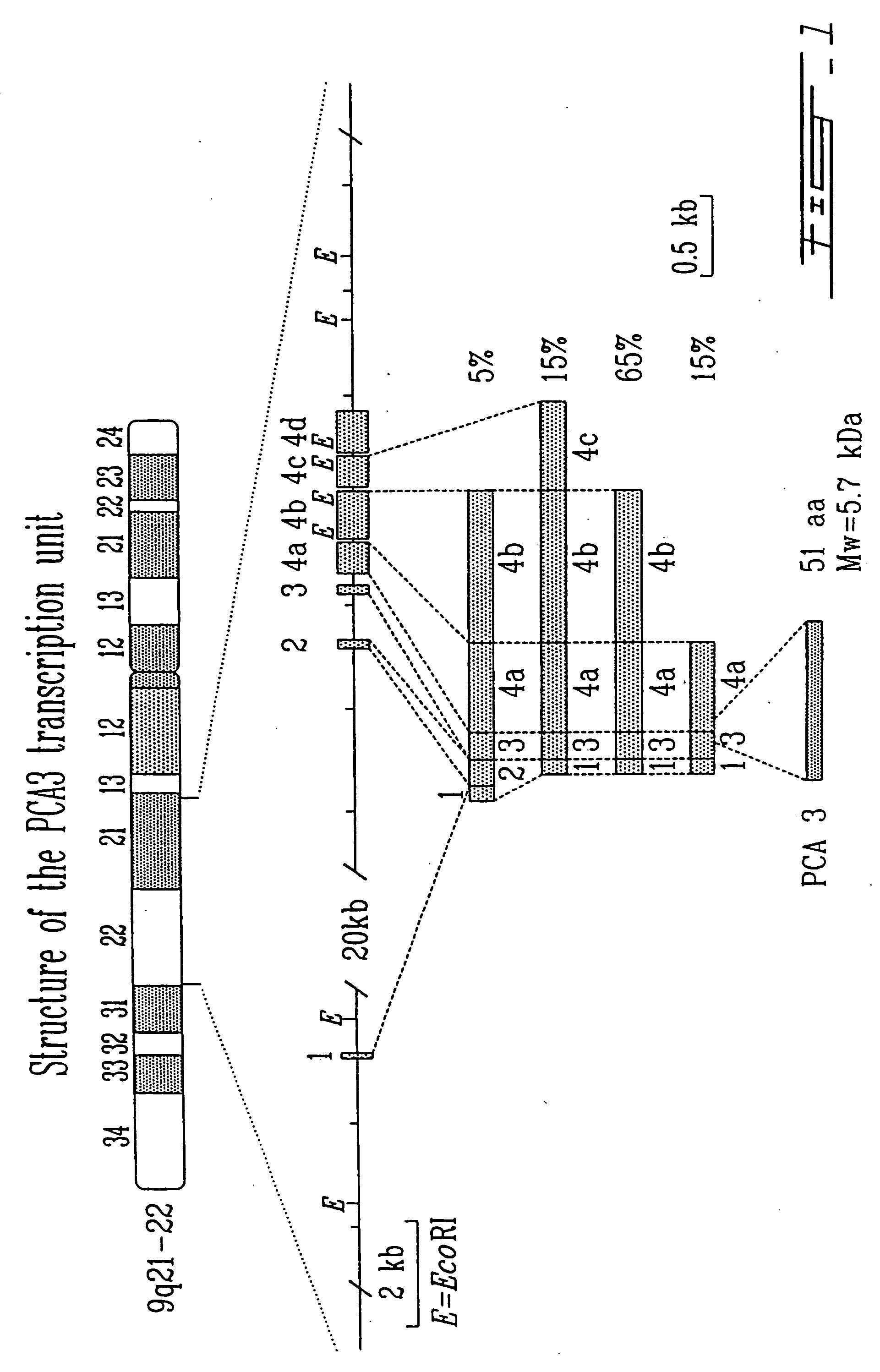PCA3, PCA3 genes, and methods of use
a prostate cancer and antigen technology, applied in the field of prostate cancer antigen, can solve the problems of no curative therapy, no evidence, and increased detection rate will decrease the mortality rate of prostate cancer-specific, and achieve the effects of reducing the toxicity of the molecule, and eliminating or attenuating any undesirable side effects of the molecul
- Summary
- Abstract
- Description
- Claims
- Application Information
AI Technical Summary
Benefits of technology
Problems solved by technology
Method used
Image
Examples
example 1
Isolation and Characterization of PCA3 cDNA and Genomic DNA
[0254] In order to identify new markers for prostate cancer, a differential display analysis (Liang et al., Science 257: 967-971 (1992)) was used to identify genes overexpressed in prostatic carcinomas in comparison to normal prostate; total RNA from normal, benign hyperplastic and malignant prostatic tissue from the same patients was extracted. Using twenty different combinations of primers (four anchored primers, five arbitrary primers), eleven apparently differentially expressed mRNAs were identified (i.e., consistently overexpressed in all carcinomas studied and not expressed in normal or BPH tissue). The complementary DNA (cDNA) fragments were used as probes for Northern blot analysis to confirm the consistent overexpression in the prostatic tumors used for the differential display. One of the probes (named DD3, a 486 bp cDNA) detected two major transcripts (2.3 and 4.0 kb) that are highly overexpressed in 47 of 50 hum...
example 2
Prostate Specific Expression of PCA3
[0274] Upon developing PCA3 specific primers, RT-PCR analysis was performed using RNA from several normal human tissues. At 40 cycles of PCR, PCA3 related products in normal prostate and BPH tissues were amplified. PCA3 expression is very prostate specific since no PCA3 product could be amplified under these conditions in the following normal human tissues: artery, brain, breast, bladder, colon, duodenum, heart, liver, lung, ovary, pancreas, placenta, seminal vesicles, skeletal muscle, skin, spinal cord, spleen and testis. Also in the human prostate cancer cell lines ALVA-31, DU145, JCA-1, PPC-1, PC3, and TSU-Pr1 no PCA3 related PCR product could be detected. In the cell line LNCaP a product can be obtained after 40 cycles of PCR (whereas under the same conditions a product can be obtained in prostatic tumors within 20 cycles). The technology used to assess the prostate specific expression of PCA3 can be adapted in a diagnostic test for prostate ...
example 3
Identification of a Transcription Start Site of PCA3
[0283] In order to determine the transcription start site of PCA3 primer extension analysis, S1-nuclease mapping and 5′RACE (rapid amplification of cDNA ends) assays were performed. The major transcription start site was found to be located within a range of 4 nucleotides (FIG. 4).
[0284] The results of these experiments further lengthen the size of the cDNA in a 5′ direction by a further 22 nt with respect to the cDNA sequence of pMB9 (SEQ ID NO:1 and FIG. 2). This additional 5′ polynucleotide sequence is also shown in SEQ ID NO:6 and FIG. 5)
PUM
| Property | Measurement | Unit |
|---|---|---|
| temperature | aaaaa | aaaaa |
| diameter | aaaaa | aaaaa |
| nucleic acid | aaaaa | aaaaa |
Abstract
Description
Claims
Application Information
 Login to View More
Login to View More - R&D
- Intellectual Property
- Life Sciences
- Materials
- Tech Scout
- Unparalleled Data Quality
- Higher Quality Content
- 60% Fewer Hallucinations
Browse by: Latest US Patents, China's latest patents, Technical Efficacy Thesaurus, Application Domain, Technology Topic, Popular Technical Reports.
© 2025 PatSnap. All rights reserved.Legal|Privacy policy|Modern Slavery Act Transparency Statement|Sitemap|About US| Contact US: help@patsnap.com



